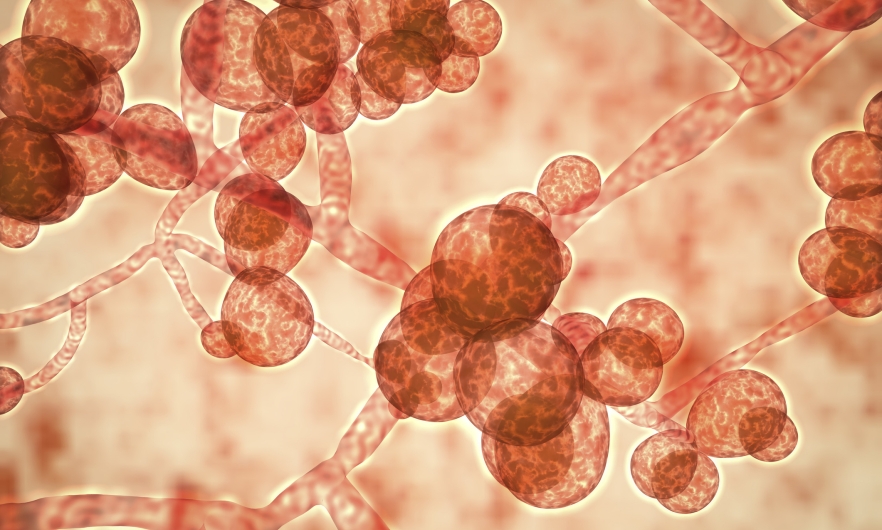A ‘Critical Pathogen’: The Rise of Drug-Resistant Fungal Diseases
A species of fungus resistant to medication poses a deadly threat to hospitals and patients.

Until recently, most fungal infections did not pose a significant threat to human health. Our advanced immune system and hot body temperature created an inhospitable environment for fungi, which mostly infected hospitalized patients or those taking immunosuppressive medication.
But over the past 10 years, the fungus Candida auris has emerged independently on three continents, suggesting that it may be the first fungus to have adapted to survive hotter temperatures. And last year, scientists in Singapore identified a new variant of this fungus, which the WHO has now labeled a “critical pathogen.”
In this Q&A, adapted from the August 26 episode of Public Health On Call, Arturo Casadevall, MD, PhD, MS, chair of Molecular Microbiology and Immunology, discusses the rise of Candida auris with Stephanie Desmon, co-author of his book What If Fungi Win?
What is the history of Candida auris?
Candida auris was not known to humanity until around 2009, when it began appearing in hospitals. The situation worsened over the next two years. From 2010 to 2012, it appeared independently in Venezuela, South Africa, and the Indian subcontinent. Since then, there have been two other emergences: one in Iran and one in Russia.
The important part is that these are not related. It’s not like somebody’s taking a plane from South Africa and carrying it to India or Venezuela. It came out of nowhere.
Last year, physicians and investigators in Singapore recovered a new clade, or variant, of Candida auris, which is very significant. Candida auris has become a major medical problem and is being declared a critical pathogen by the WHO.
How is Candida auris spreading?
We don’t know. I proposed a few years ago with some colleagues that it is the result of global warming. Fungi are not new. They’ve been living out there for a very long time, possibly millions of years.
Most fungi can’t cause disease in humans because they can’t grow at our temperature, which is 98 degrees Fahrenheit. But as the world gets warmer, fungi have to adapt to higher temperatures or perish. So the thought is that the fungus has been adapting to the environment, and then got into a situation where it can infect humans, and we have a new emergence.
How much of a risk is Candida auris to humans?
To immunocompetent humans, it is not thought to be a big risk right now, but it is a big risk for anyone who is debilitated or immunosuppressed. Once it gets into a hospital, it is hard to get out. It tends to attach very strongly to surfaces, to beds, to bed railings, and it is also resistant to two of our three major antifungal drugs. So it is a serious problem, and the problem appears to be getting worse. And if Candida auris is in your hospital, you can’t necessarily conclude that it was carried there. It may have emerged in your region.
Are there more fungi like Candida auris out there?
Absolutely, and that’s the big concern. The fungal world is enormous. The number of species is in the millions. Many of them are major pathogens of plants, insects, invertebrates, and even cold-blooded vertebrates. The fungal kingdom has a lot of pathogenic potential, yet we don’t worry about it too much because our temperature protects us. However, if they continue to adapt, and we basically have something that can cause disease in a plant or an insect that now can grow at higher temperatures, it is a potential threat, and that is what we worry about.
Have we seen Candida auris in the U.S.?
A year or two ago, the CDC published a major study showing that not only was it rapidly spreading to the United States, but most concerning was that it was developing resistance to our last antifungal. So we have increased dissemination of an organism with significant capacity to cause morbidity and mortality, and now the organism is also becoming more resistant, because if we only have one good drug against it, that’s what we use.
What happens when the antifungal drugs no longer work?
Things will become much more difficult than they are, but hopefully, there will be more drugs in development, and new ones will become available that we can use for therapy.
This is why infection control is so important. You do not want to rely on therapy. You want to prevent the problem, because when you get to needing therapy, then you always get into the danger of drug resistance.
What can we do now to ensure more people don’t get sick?
We have to redouble infection control because we know that it spreads from person to person. It can be carried on by individuals’ caregivers. So we need to make sure it doesn't spread. We have to try to localize the problem as much as possible and eradicate it locally.
Candida auris is sufficiently spread and is in so many hospitals that it will continue to be a problem going forward. We need better drugs, and we need more surveillance. We need to know more about what’s in the environment.
The fact is that when we get surprised by nature, it’s always devastating. The HIV pandemic was a surprise. The coronavirus pandemic was a surprise. The rise of Candida auris is a surprise. And I think we need to be more proactive and prepare better. When we get hit with a pandemic, the problems are much greater than they would have been had we expanded on preparedness.
This interview was edited for length and clarity by Rin Swann.





